Prepared by Fredric Miller, Illinois Forest Health Specialist TheMorton Arboretum, Lisle, IL
FOREST HEALTH ISSUES FOR 2021: AN OVERVIEW
2021 was a challenging year for trees. We started off with a very warm and dry spring which continued throughout most of the summer and fall. Other areas experienced excessive rainfall leading to flooding and severe weather resulting in a few damaging tornadoes. On the bright side, the dry and warm spring, did help reduce the incidence of foliar diseases like apple scab, cedar apple rust, powdery mildew, anthracnose, needle tip blight of pines, junipers, and arborvitae, and needle cast diseases. Continuing statewide issues included herbicide injury to oaks and other hardwood tree species, decline of spruces and pines, and rapid mortality of white oaks. Emerald ash borer (EAB) populations were continued to progress in areas of central and southern Illinois. We were on the lookout for the diseases Sudden Oak Death (SOD) and Laurel Wilt (LW) but fortunately, neither one was detected. In 2021, we completed our Play-Clean-Go (PCG) installing approximately 60 boot brush stations (BBSs) on state lands to help mitigate the spread of invasive plant species in our forests and woodlands.
Note: In the 2021 issues of Illinois Forest Health Highlights (IFHHs) will focus on new and emerging and few on-going forest health issues (i.e. spotted lanternfly, elm zigzag sawfly, laurel wilt, weather, rapid white oak mortality, and herbicide drift) affecting forest tree and woody plant species. Be sure to check out new highlights including sudden oak death surveys (pg. 5), laurel wilt surveys (pg. 5), invasive plant control (pg. 12), spotted lanternfly updates (pg. 13), and 2021 weather(pg. 16).Fordetails onchronic insect pests (i.e. EAB) and diseases (foliar and needle cast diseases, cankers), please refer to previous issues of IFHHs.
PLANT DISEASES AND HERBICIDE DRIFT DAMAGE
Herbicide Drift Damage (2, 4, 5)
Signs of herbicide damage to trees continued to be reported statewide in 2021, particularly on state and private lands bordering agricultural fields.
Types of herbicides. In general, herbicides are classified based on the types of weeds they control (grasses, broadleaf plants, woody plants, etc.), when they are applied (i.e. pre- or post- emergence), and their mode of action. Post-emergence broadleaf herbicides selectively kill actively growing broadleaf plants and include growth regulator herbicides containing active ingredients found in 2,4-D, 2,4-DP, MCPA, MCPP, and Dicamba. These products have broad application including homes, farms, and industry. They are prone to drift and volatilization.
Injury symptoms associated with these herbicides include twisted and downward cupping of leaves, and narrow, strap-like leaves on the youngest growth (Figure 1). Root uptake of these chemicals is usually more damaging to the plant and on grape the leaves will cup upward (Figure 2). These herbicides are fairly soluble and can move through the soil as well as air. As their name implies, grass herbicides kill grassy weeds. They may be applied pre- or post- emergence. Common pre-emergence herbicides include trifluralin and DCPA. Post-emergence herbicides include fenoxaprop, sethoxydim, and fluaziop-P. These products cause yellowing/bleaching of leaves and dieback of actively growing regions. Pre-emergent products are less likely to drift compared to post-emergence herbicides. Non-selective, post-emergence, broad spectrum herbicides are basically designed to kill a wide variety of plants and include paraquat, glufosinate, and glyphosate.

Figure 1: Suspected herbicide damage to oak leaves. Mature oak leaves displaying severe distortion, cupping, twisting and strapping due to suspected herbicide damage.
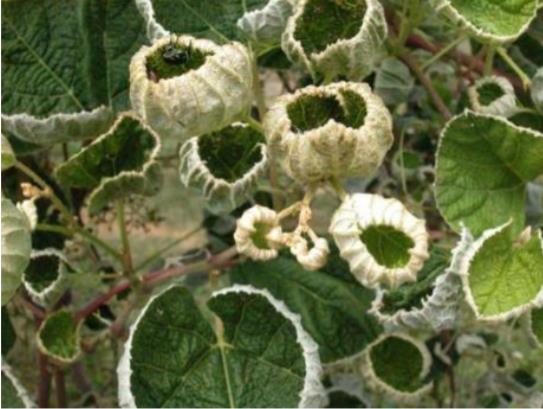
Figure 2: Herbicide damage on grape, most likely due to root intake (upward cupping leaves).
A list of tree species sensitive to phenoxy herbicides (i.e. Butoxone, 2,4,-D, MCPA, 2,4,5-T, silvex, and Banvel) is presented in Table 1
Table 1. Sensitivity of various trees species to broadleaf weed-killers (Taken from Hibbs, 1978).
| Sensitive | Intermediate/Unknown | Tolerant |
| Apple | Cherry | Catalpa |
| Ash | Cottonwood | Linden |
| Amur cork tree | Honeylocust | |
| Birch | Mulberry | |
| Boxelder | Oaks | |
| Elm | Silver Maple | |
| Hackberry | ||
| Hickory | ||
| Horsechestnut | ||
| Maple (sugar, red and Amur) | ||
| Redbud | ||
| Sycamore | ||
| Walnut |
Herbicide drift. Like with all pesticides, herbicide drift can be a problem. Factors affecting drift potential include formulation, application method, air temperature, wind, and soil factors. For example, 2,4-D (low volatile ester formulations) can vaporize and be carried by the wind while 2,4-D (amine formulations) are less likely to vaporize. Granular formulations rarely move or volatilize. It is well known that the smaller the droplet size the higher the drift potential. To avoid drift issues, it is recommended to produce larger droplet sizes along with lower pressures or use sprayers with larger orifice nozzles. Weather factors such as air temperature, wind, and relative humidity (RH) may also contribute to herbicide drift. Some herbicides may vaporize at temperatures greater than 85oF during or immediately after application. Herbicides in a vapor state can move large distances and can cause plant damage considerable distances from the point of application. Producing larger droplets and applying them closer to the target plants can minimize wind drift. Soil factors also play a role in herbicide drift. The amount of uptake by a soil-applied herbicide depends on the type of herbicide, location of plant roots in the soil, soil type, and soil moisture. Some herbicides are mobile and move rapidly in sandy and/or porous soils while others may persist in the soil.
Diagnosing herbicide drift damage. Be careful not to jump to premature conclusions when attempting to diagnose for herbicide or other chemical injury.Correct tree diagnostics is all about “patterns, patterns, patterns”. For example, are several different tree species impacted, or just one species? Is only one part of the trees impacted, or is damage more widespread? Other maladies may mimic herbicide damage including low temperature injury, foliar diseases (i.e. anthracnose), insect feeding (i.e. plant bugs, leafhoppers), and air pollutants. Some tree species may show damage while others will not.
A question to ask is, is only the new growth affected or is the entire canopy impacted? If it is a one-time event, then later new growth should look normal. In some cases, leaf tissue analysis may be required to determine which chemical is involved in plant damage. Has there been any disturbance to the soil around or near the tree(s) (i.e. addition of fill, construction activity, soil compaction, etc.), are there of girdling roots present, and has there been a drought or flooding? Remember, most of our problems we see with trees usually start below ground.
Managing chemical drift damage. Unfortunately, for rural forested areas and woodlots, there is really no practical treatment other than to reduce stress factors in areas where tree symptoms are being observed. Trees growing in urban areas and home landscapes should be protected from predisposing stress factors such as construction injury, soil compaction, changes in drainage, competition from turf, and drought. Focus on tree health and vitality by mulching, watering during dry spells, and fertilizing where appropriate if nutrient deficiencies are present.
Remember, older mature and over-mature trees do not react well to changes in their immediate growing environment. In most cases, healthy trees will recover from chemical damage the following season, but chronic exposure to herbicides along with the aforementioned pre- disposing factors may be enough to cause the tree to begin to decline ultimately resulting in death. If you have to apply an herbicide for any reason, avoid herbicide drift by not spraying when cross winds exceed 10 mph, using lower pressures, and using spray nozzles that produce large-sized droplets.
Herbicide Damage Survey Results.We still have a lot to learn about spray drift and all of the related factors contributing to herbicides moving off-target. In 2018, we initiated a statewide survey to obtain a better idea of how extensive the problem is and to better understand the causes contributing to leaf tatters and/or herbicide drift and the relationship between chronic chemical drift exposure and its effect on long-term tree health. A summary of herbicide leaf tissue sampling for 2018-2020 is presented in Table 2.In 2018, 2019, 2020, and 2021 35, 28, 50, and 30 leaf tissue samples were taken and submitted to a lab to test for evidence of dicamba and/or 2,4-D damage, respectively. Results for 2021 leaf tissue sampling are pending.
Table 2.Summary of herbicide leaf tissue sample test results for 2018 – 2020.
| 2018 | 2019 | 2020 | 2018 | 2019 | 2020 | 2018 | 2019 | 2020 | |
| Chemical | % | % | % | Mean | Mean | Mean | Range | Range | Range |
| of | of | of | (ppb) | (ppb) | (ppb | (ppb) | (ppb) | (ppb) | |
| Total | Total | Total | |||||||
| 2,4-D | 74% | 96% | NT1 | 29.1 | 47.1 | NT | <2.0-173 | 3.9-13.9 | NT |
| Dicamba | 11% | 100% | 68% | 5.2 | 8.3 | 4.6 | 1.4-8.6 | 3.1-40.9 | 1.9-17.9 |
| Triclopyr | 11% | 21% | NT | 61.0 | 10.2 | NT | <5-90.4 | <5-14.4 | NT |
| 1NT=Not Tested |
SUDDEN OAK DEATH (SOD)(1, 12, 14)
SOD is a disease of oaks caused by the pathogen Phytophthora ramorum, a water mold that also impacts over 100 other plant species throughout the world. The disease was originally detected in California in the 1990’s and has since killed millions of oaks on the West Coast. The pathogen can spread through infected nursery stock and surface water. In 2020, it was detected in plants distributed to retail locations throughout Illinois. To determine whether the pathogen had the potential to spread from these locations to neighboring natural areas and parks, in the spring of 2020 and spring and fall of 2021, surface waters around these locations were baited and tested for P. ramorum. To date, test results have been all negative and the pathogen was not detected. Testing will continue in 2022.
LAUREL WILTAND THE REDBAY AMBROSIA BEETLE (10, 13, 15)
Another serious disease that we are monitoring for is Laurel Wilt. It is a fungal wilt disease caused by the pathogen Raffaelea lauricolawhich is spread primarily by the tiny redbay ambrosia beetle (Xyleborus glabratus) and several other beetle species. The disease has killed hundreds of millions of redbay (Persea borbonia) and swamp bay (P. palustris) trees, two important understory species, in the southeastern United States. The fungus also affects other members of the laurel family (Lauraceae) including sassafras (Sassafras albidum), spicebush (Linderabenzoin), and commercially grown avocado (P. americana) trees. Like other wilt diseases, the fungus induces a reaction in the tree that restricts the flow of water, causing leaves and branches to wilt and turn brown, and eventually killing the entire tree (Figure 3). The redbay ambrosia beetle is very small (about 2 mm long) and is rarely seen (Figure 4), although signs including small exit holes, sawdust “noodles”, or fine sawdust can indicate their presence. For noodle images refer to https://www.forestryimages.org/search/action.cfm?q=ambrosia+beetle+noodle.
Although redbay trees do not grow in Illinois, sassafras is an important part of ecosystems in the southern part of the state and is susceptible to the wilt. The pathogen was recently detected in western Kentucky, so the disease and the beetle vector were monitored for in 2020 and 2021 in
southern and central Illinois. To date, no symptomatic trees or red bay beetles were detected.
We will continue in 2022 to monitor for this destructive fungus and its vector.
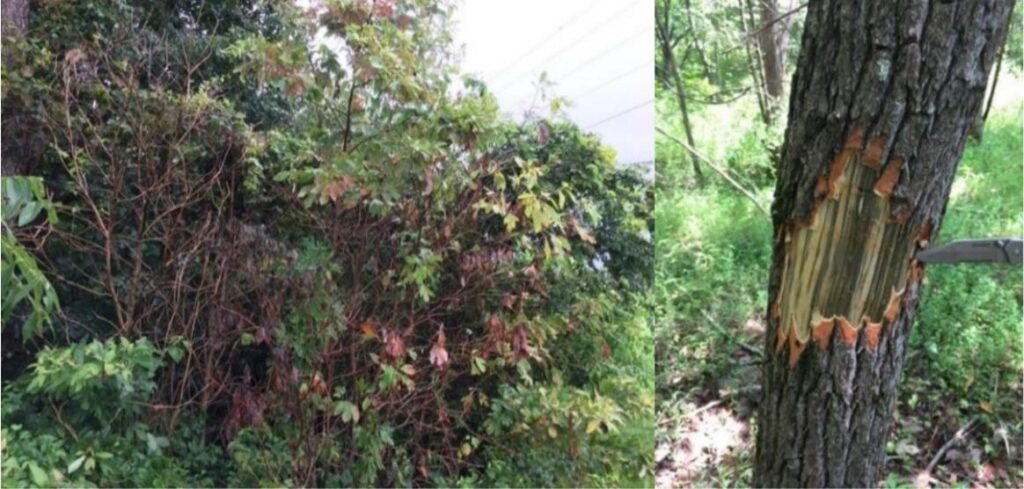
Figure 3. Signs of laurel wilt in sassafras: brown wilted leaves (L) and dark streaks under the bark (R). Photo courtesy of University of Kentucky College of Agriculture, Food and the Environment.
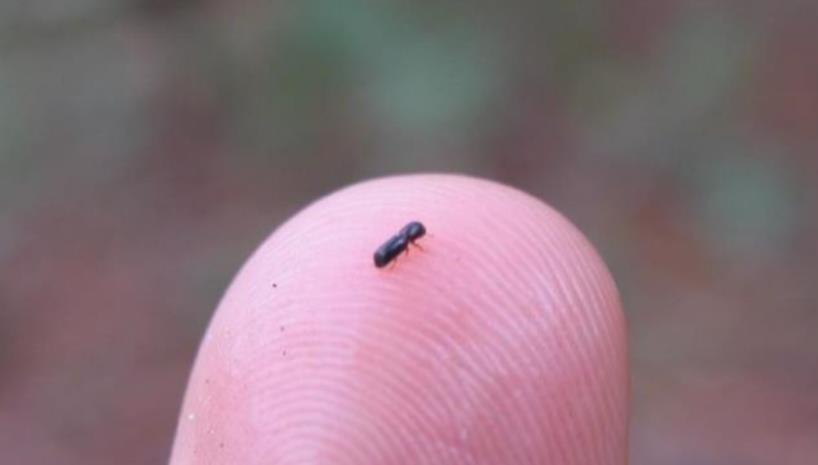
Figure 4. The redbay ambrosia beetle on a finger for scale. Photo courtesy of USDA Forest Service.
OAK WILT (7)
Oak wilt is found in every Illinois county and has become a major urban and forest tree disease. Oak wilt levels for 2021 were comparable to previous years. This fungal disease is lethal to oaks, particularly oaks in the red oak group, and trees must be treated preventatively with fungicides to insure survival. Anthracnose may be confused with oak wilt later in the season. (Figure 5) Be sure to properly diagnosis the problem before employing management options. Prevention is important, so remember not to prune between April and September, and consult with experts before removing an infected tree because the disease can spread through the root grafts. The only way to be absolutely sure of a diagnosis is to send in samples to a plant clinic to confirm which fungus is involved. Keep in mind, that a tree could have both oak wilt and anthracnose at the same time.
For more information about Oak Wilt, please consult the Illinois Forest Health Highlights from previous years.

Figure 5: Side by side comparison of oak wilt and anthracnose symptoms in oak. The bottom left photo shows the dark streaking under the bark in oak wilt.
RAPID WHITE OAK MORTALITY (RWOM)(6)
We continue to be on the alert for RWOM, which has been observed in parts of Missouri since 2012 and in Illinois for the last few years. Reports continued to be received from Illinois in 2021 involving rapid decline (within one growing season) and death of white oaks and other oak species (Figures 6 and 7). Further monitoring and field studies are planned for 2022 to determine what factor(s) may be responsible for RWOM. Field observations in 2021 suggest that record breaking spring precipitation (i.e. 2017-2020) followed by hot, dry summers, may have led to a build-up of Phytophthora and other root-rotting fungal pathogens. The only way to accurately diagnose which pathogen is causing a root rot is through laboratory diagnosis. An intensive research effort is planned for 2022 to better understand the relationship between abiotic and biotic factors and their role in RWOM.
For additional details on RWOM, refer to Missouri Forest Health Update (December, 2014) pages 5-6 (11) and the 2020 Illinois Forest Health Highlight (page8).
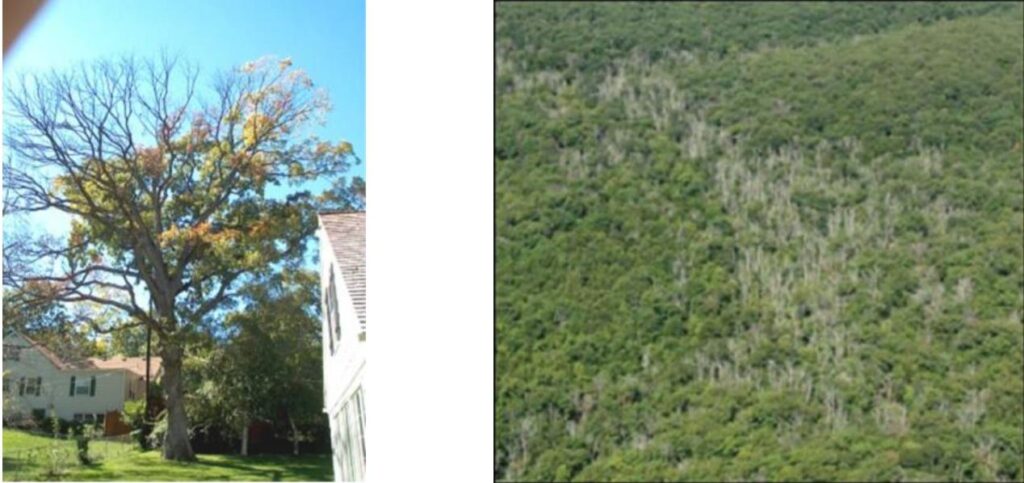
Figures 6 and 7: White oaks dying from RWOM.
THOUSAND CANKERS DISEASE(TCD)OF EASTERN BLACK WALNUT
To date, neither the walnut twig beetle (WTB) or the TCD fungus has been detected in eastern black walnut trees in Illinois, and no new finds have been reported for areas of the eastern U.S.
BUR OAK BLIGHT (BOB)(3, 9)
Bur oak blight (BOB) continued to be a present in 2021. The fungal disease was first reported in Illinois in 2012. Initial finds were in northern Illinois, but more recently, BOB has been found in central Illinois counties (Figure8).

Figure 8: Distribution of BOB in Illinois, 2019.
Details on the biology, impact, and management of BOB has been reported in previous editions of the Forest Health Highlights (FHH) and also in the September 11, 2017 issue of the University of Illinois,Home,Yard, and Garden Newsletter.
BOB is more of a chronic disease to bur oak, but may eventually kill a tree over a period of years. Sampling for BOB is best conducted in late summer (i.e. August and September) when the disease is fully expressed (Figures 9-12).

Figure 9: Bur oak blight (BOB) leaf symptoms on underside of leaf.

Figure 10: Bur oak leaf blight symptoms.

Figure 11: Bur oak blight (BOB) on bur oak.

Figure 12: Black, pimple like fungal fruiting bodies on bur oak leaf petiole.
INVASIVE PLANTS
One of the major threats to the health of our forests is invasive plants, plants that have been introduced from other parts of the world, and lack of natural controls to keep them in check. They can take over forests and out-compete our native plants. This year, the Illinois Forest Health Program broadened to address this important issue by expanding the Play-Clean-Go (PCG) campaign in Illinois through a multi-state grant-coordinated by the North American Invasive Species Management Alliance (NAISMA). PCG promotes the protection of our natural resources by educating outdoor enthusiasts of the dangers of invasive pests in our natural areas. Part of their campaign focuses on the installation of boot brush stations (BBSs) with educational signage to help promote the message of slowing and stopping the spread of invasive plant species. The goal of these stations is to inform park visitors of the importance of keeping our forests healthy and to provide a useful tool for removing any invasive plant seeds that may be lingering on their footwear. The signs also provide examples of the common invasive plant species found in each park’s area of the state (Figure 13). We expanded on the work started by partners in southern Illinois by ordering 72 more stations to be installed at trail heads in many of our parks. Sixty (60) additional stations were installed on state lands in central and northern Illinois. Keep an eye out for these stations in state parks and natural areas as they are installed by local volunteers and park staff!

Figure 13: A recently installed boot brush station (photo courtesy of NAISMA).
NEW INVASIVE PESTS
Spotted Lanternfly (8, 11)
The spotted lanternfly (SLF) (Lycorma delicatula) has now been detected in many eastern and northeastern states and more recently, as close as Indiana. Native to China and found in India, Japan, Korea, and Vietnam, the SLF apparently is considered highly invasive due to its wide host range of more than 70 plant species and lack of natural enemies. The young nymphs are wingless, black initially, but developing red patches as they mature, and have white spots on their body and legs. Adults are large (1-inch-long and ½ inch wide) with black legs and head, yellow abdomen, and light-brown to gray forewings (Figure 14 and 15). The hind wings are scarlet red with black spots. SLF females lay egg masses containing 30-50 eggs that are gray- brown and covered with a shiny grey waxy covering. The SLF has one generation per year (univoltine) with eggs hatching in the spring and early summer and adults appearing in July through August. Egg-laying begins in September and continues through November (Figure 16).
Upon egg hatch, the young nymphs disperse and begin feeding on a wide range of hosts producing large amounts of honeydew. Adults are found on tree trunks, stems, and near leaf litter at the base of the tree. Adults are poor flyers, but strong jumpers. They favor Tree-of-Heaven (Ailanthus altissima), black walnut (Juglans nigra), and grapevine (Vitis vinifera) as host plants. In the fall, the adults seek out Tree-of-Heaven for feeding and egg laying. Adult females will tend to lay eggs on smooth-trunked trees or any vertical smooth natural and/or man-made surface. They are able to lay egg masses on trucks, train cars, RV’s, etc. and can easily travel to new locations. Heavy feeding may lead to plant stress and may lead to plant death. Sooty mold typically develops in association with honeydew diminishing the plant’s ability to produce food (photosynthates). The SLF has the potential to greatly impact the grape, orchard, logging, tree and wood-products, and green industries.
Since Tree-of-Heaven (Figure17), also non-native and invasive and is a critical host for SLF for part of its life cycle, efforts to prepare for the potential spread of SLF have thus far included a statewide survey of locations of Tree-of-Heaven. Knowing the locations of populations of the tree will aid us in monitoring and responding to this pest threat.

Figure 14: Spotted lanternfly nymph (Left) and Adult spotted lanternfly (Right).

Figure 15: Adult spotted lanternfly.
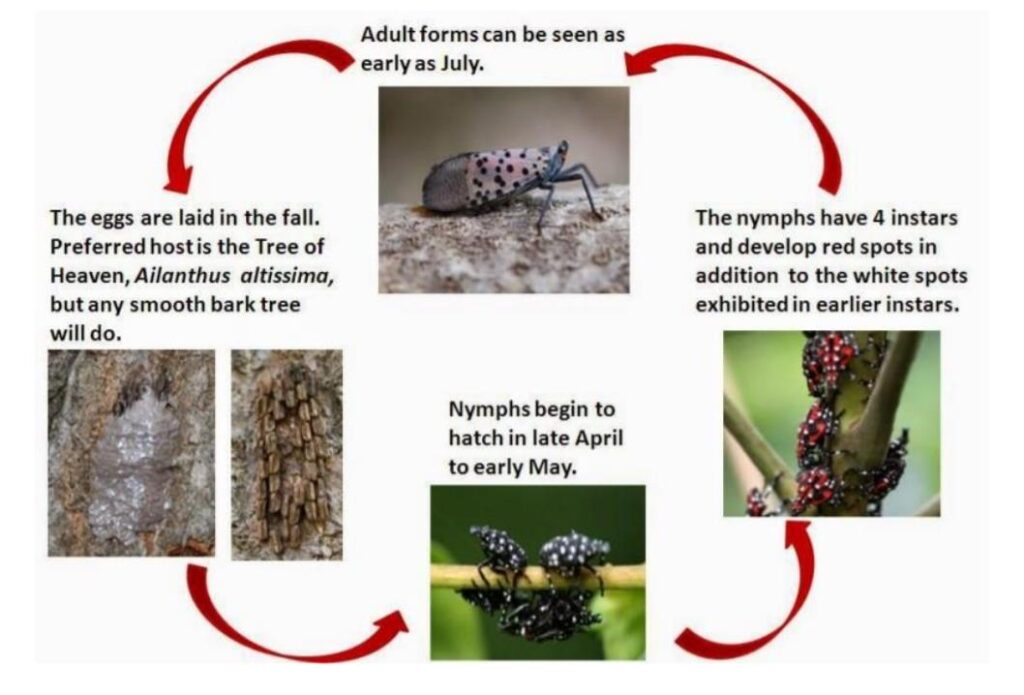
Figure 16: Life cycle of the spotted lanternfly.
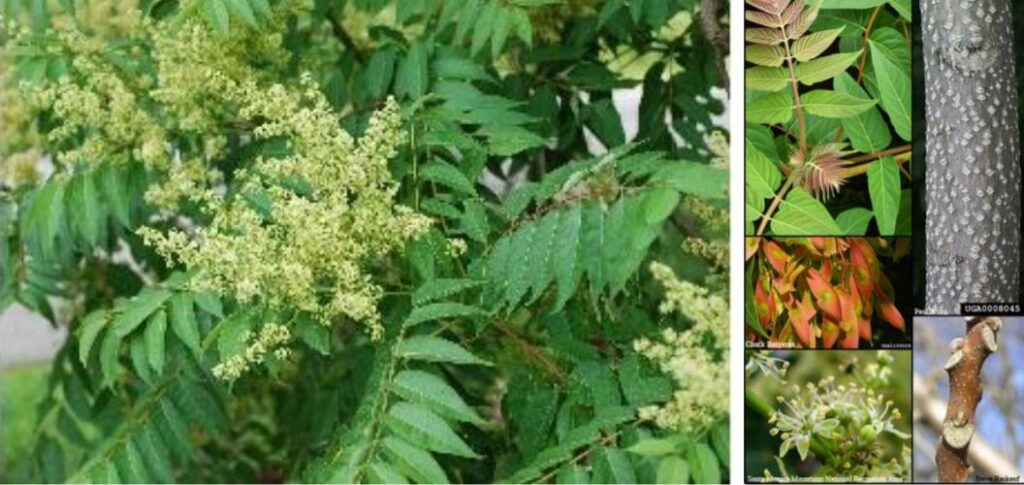
Figure 17: Photos of Tree-of-Heaven. Courtesy of USDA NRCS (L) and Northwest Michigan Invasive Species Network (R).
Zig-zag Elm Sawfly
What a name! The zig-zag sawfly (Aproceros leucopoda), which is native to Asia found its way to Canada in 2000 and to the U.S (Virginia) in 2021. It is a defoliator of most elms particularly Siberian elms (Ulmus pumila) and American elm (U. americana). The jury is still out as to whether it will be a serious problem for other elm species and hybrids. There is the potential for the insect to have important ecological impacts for elms used in urban forests and landscapes and the fact that 500 insect species depend on elms. The sawfly reproduces parthenogenetically (no males) and can have 4 to 6 generations per year (Scary!). The adults are strong flyers (can disperse 30 to 50 miles per year). The larvae feed from the edge of leaf in a zigzag pattern.
After pupation, very rapid adult emergence follows (Figures 18 and 19).

Figure 18: Elm zigzag sawfly larva and feeding damage
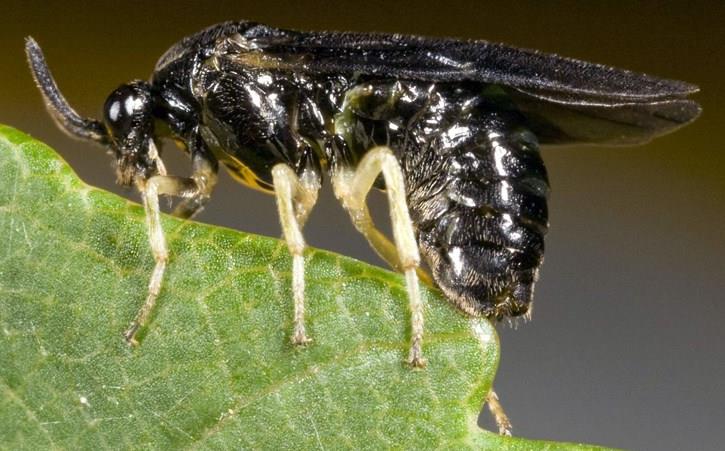
Figure 19: Adult elm zigzag sawfly
WEATHER AND ABIOTIC EVENTS: 2021 WEATHER TRENDS
The weather for 2021 deviated from previous springs with warm and dry conditions for most of Illinois. Overall, we had a “dry” winter with most of the snowfall having low moisture content. Most of the precipitation came in downpours and was spotty with long dry spells in between until the latter half of June (Figures 20 and 21). Precipitation improved by October 2021, with
3.44 inches above the 10-year average making it the 4th wettest on record going back to 1895, however, most of northern Illinois is still under mild to moderate drought as of late November, 2021 (Figures 22 -24). Total November precipitation ranged from less than a quarter of an inch in northwest Illinois to just over 2 inches in southeast Illinois, between 2 and 4 inches below normal. The dry conditions added to existing precipitation deficits in northern Illinois, and in response there has not been much of a change in the U.S. Drought Monitor during November, 2021. Most areas between Whiteside County in northwest Illinois and Lake County in northeast Illinois remain in moderate to severe drought as year-to-date precipitation deficits of 6 to 12 inches remain. January 1 through November 30 is the second driest on record in Rockford, greater only than 2012. Rockford will need at least 1.11 inches of precipitation in December to keep 2021 from being the driest calendar year on record there. The preliminary statewide average total November precipitation was 1.00 inches, 2.31 inches below the 1991–2020 average and the ninth driest on record going back to 1895 (Figure 25) (Illinois CoCoRaHS Newsletter Vol. 14, No. 12, December 2021).
Storms were common throughout Illinois including an EF-3 tornado which moved through portions of DuPage and Cook counties in mid-June. Extensive tree and structural damage occurred in the affected area, but fortunately, there was no loss of life. Long-term restoration pruning for damaged trees will be the rule for the next number of years (Figure 26).

Figure 20: Accumulated precipitation (in.) (left) and departure from mean for May, 2021 (right)
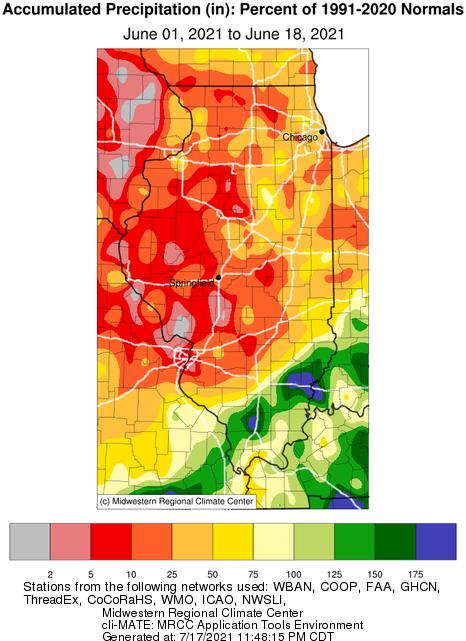
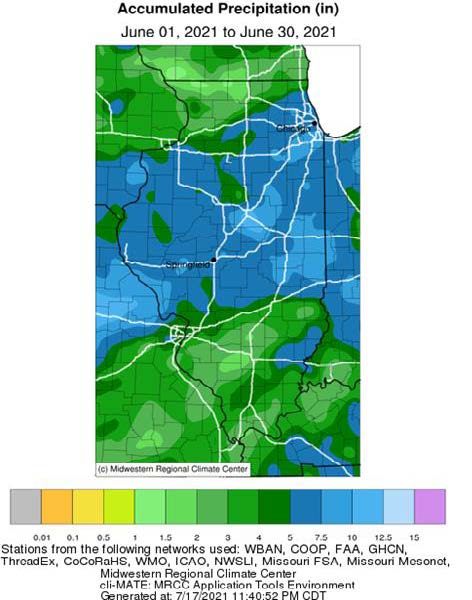
Figure 21: Accumulated precipitation (in.) (right) and departure from mean for June 2021 (left)

Figure 22: Accumulated precipitation (in.) (left) and departure from mean for September 2021 (right).

Figure 23: Drought monitor map for Illinois as of October 2021.
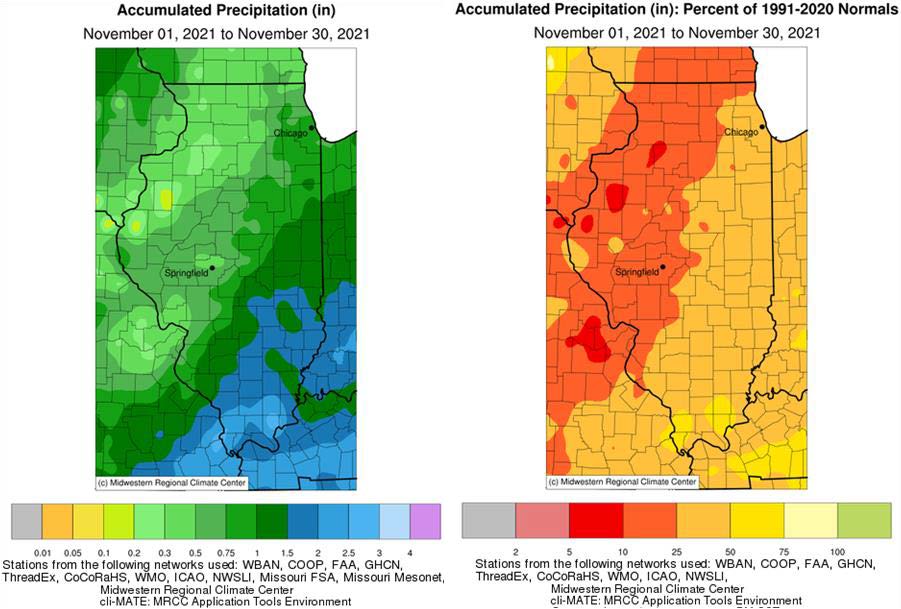
Figure 24: Accumulated precipitation (in.) (left) and departure from mean for November, 2021 (right).
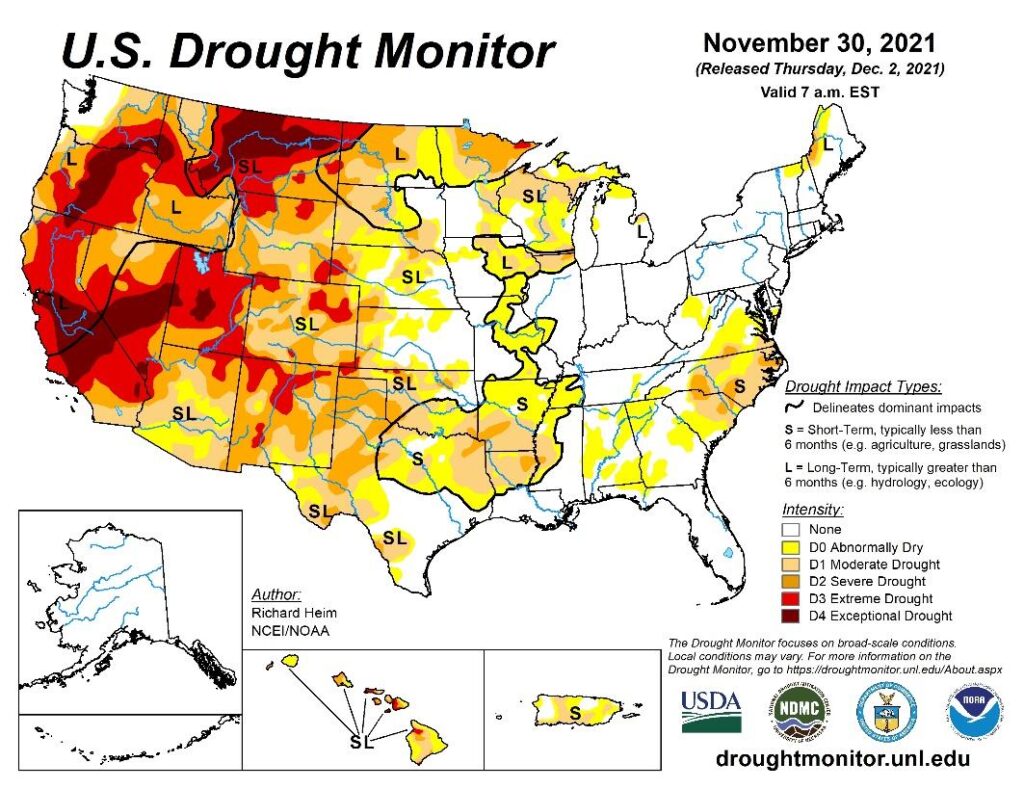
Figure 25: U.S. drought monitor for November 2021.

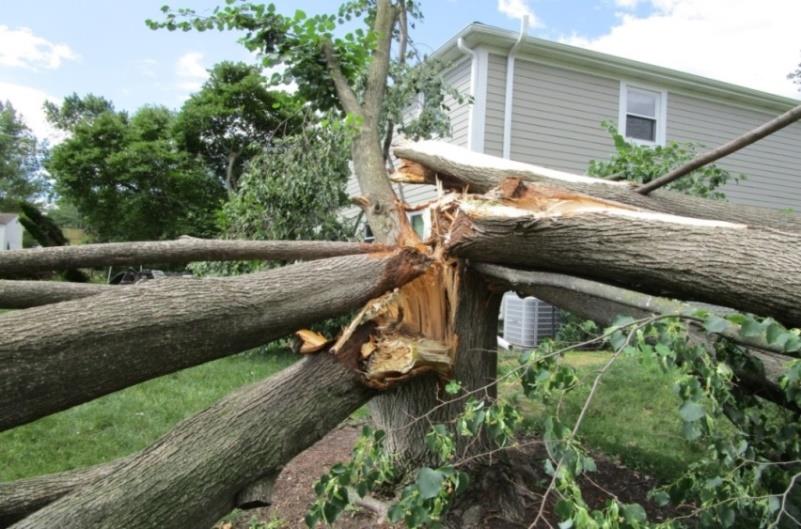
REFERENCES AND SUGGESTED READINGS
PLEASE NOTE: The information presented in this summary is not to be considered comprehensive or all inclusive. Information presented hereis based on visual and observational surveys and reports by Fredric Miller, Ph.D., IDNR Forest Health Specialist, and Morton Arboretum, ResearchInterns., IDNR Forest Health field technicians, IDNRdistrict foresters, private landowners, homeowners, TheMorton Arboretum Plant Diagnostic Clinic, and members of thegreen industry.
REPORT PREPARED BY: Fredric Miller, Ph.D. IDNR Forest Health Specialist with assistance from Liz Prazak, Morton Arboretum Research Intern, Lisle, Illinois.
This project was funded in whole or in part through a grant awarded by the USDA, Forest Service, Northeastern Area State and Private Forestry. The USDA is an equal opportunity provider and employer.